Spider-view: Venom: Lethal Protector (Venom, Part 9)
Venom's inaugural series relies too heavily on a popular co-star to allow its title character proper space to develop as a hero
—by Nathan on April 6, 2025—
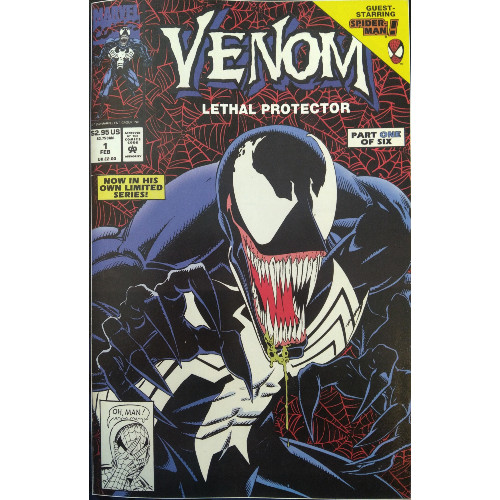
How plans change.
I first wrote a blog post reviewing this series when I picked up a 1,000+-page book called Venomnibus: Volume 1. The giant tome contains a treasure trove of limited series, one shots, and other Venom issues, if you treasure that kind of trove. I probably wrote the first review some time shortly after COVID hit, so roughly within the last five years. But plans changed, and I ended up starting "Spider-view" with stories from the 80s instead of the 90s, and as other writing projects crept in, it just took me a long time to get back to this point.
Which, I felt, meant this story deserved a re-read…and the initial review a rewrite.
In Amazing Spider-Man #375, an anniversary issue marking 30 years since the publication of Amazing Spider-Man #1, David Michelinie and Mark Bagley crafted the conclusion of a two-part Venom tale in which Spider-Man made a deal with his deadliest, most persistent of foes: as thanks for Spidey saving the wife of Eddie's ex-wife Anne Weying, and in exchange for letting Eddie go, Venom promised to not try and murder Spidey any longer. Spidey lets him go, Venom drops his vendetta. Despite the numerous occasions where Venom had attempted to rip his head off, drink his spinal fluids, eats his brains, etc., Peter agreed…and let the symbiote-suited supervillain get away Mr. Miracle. That is, Scott Free.
It was a controversial decision (and one which a later "Clone Saga" narrative would take to task in an entertaining fashion), but it distanced Venom from Spidey. The villain swung to the other side of the country to put some space between him and his most-hated enemy. So we shouldn't be seeing any of Spider-Man in the brain-eater's first limited series, right, Michelinie?
Right…?
Venom: Lethal Protector
Writer: David Michelinie
Pencilers: Mark Bagley and Ron Lim
Inkers: Sam de la Rosa and Al Milgrom
Colorist: Marie Javins
Letterers: Richard Starkings and Rick Parker
Issues: Venom: Lethal Protector #1-6
Publication Dates: February 1993-July 1993
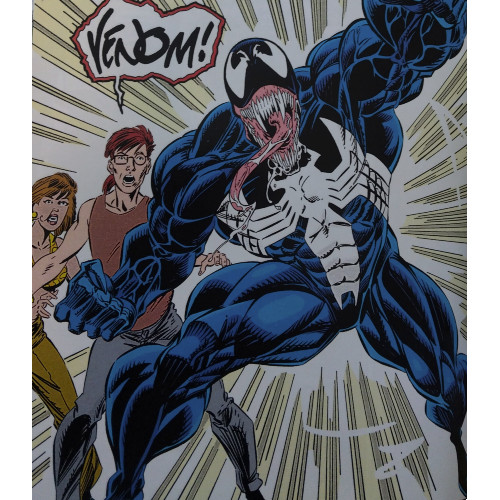
You would think, hope, assume, or wish that, in a narrative picking up almost immediately after the events of ASM #375, Michelinie would take to heart the deal Venom and Spider-Man made, really lean into the whole element of making Venom a character separate from his origins, someone not wholly independent on having a certain red-and-blue guest star follow his errant adventures, even if that red-and-blue guest star was a highly popular figure starring in at least four titles of his own. And why should he pop up? He's starring in four titles of his own!
As I have commented on before, I am fully cognizant of Venom's star power, which explains why Michelinie steers Venom in the anti-hero direction with gusto in this limited series. We've already seen Venom's insistence on his own innocence and attempts to protect those he would deem innocent, whether they be helpless babies or Peter Parker's own parents, seemingly back from the dead. It's the character's guiding principle, pitting him against Spider-Man and even explaining why he'll murder a mugger to save someone in an alleyway. The victim is innocent, the mugger isn't, and Venom will unleash his own brand of Punisher-style justice on those he deems worthy of retribution. Stronger, more powerful, able to evade Peter's spider-sense…Venom is a darker, almost better (as in, more efficient) Spider-Man. More power, no responsibility. If you murder a crook, he can't hurt anybody anymore, right?
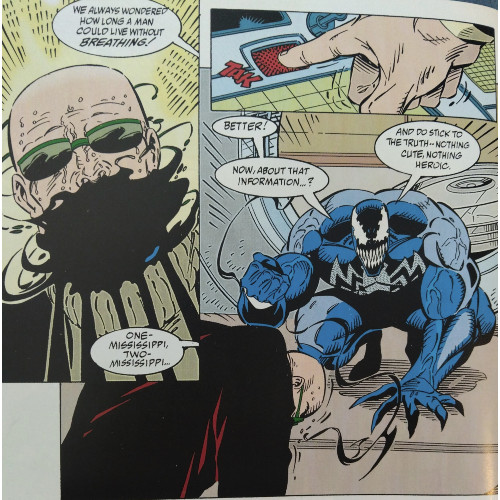
Michelinie endeavors to toy with Venom's seemingly conflicting values, setting him up as a character we do want to root for and empathize with even while critiquing the brutal methods he uses to secure justice. You've seen it before in characters such as Deadpool, Wolverine, and the Punisher, but all those guys were heroic from the start. This Venom dude started life as a villain, simply destructive, and in a new city, with a seemingly new lease on life, Eddie Brock can start over and divorce himself from his demons.
That's what Michelinie wants you to believe, anyway.
The writer's intentions are divided against themselves, at best. In one, alien-augmented, clawed hand is the hope the reader will empathize with Eddie's position, that Michelinie has done enough in previous stories to make you believe Venom really could change so drastically. Not that he'd surrender his violent tendencies but that those tendencies could be channeled into a dramatic stand for truth and righteousness and that the audience will fully agree with the direction. In the other, alien-augmented, clawed hand is Michelinie's desire to cling to the seemingly inescapable past, to dredge up the one guy who Venom said he'd leave alone, and remind us that, at least with this series, Venom cannot fully escape his regrets.

I decry the use of Spider-Man in this series for the singular reason that it means Michelinie fails to make Venom an intriguing proto-protagonist on his own merit. I believe Venom should have, at least for six stinking issues, been allowed freedom from the spider's web. I also question Spidey's intentions as an argument from the writer to justify Peter Parker hopping on a plane to San Francisco–Peter fears that the deal he made (which took him all of two panels to agree to) was an error and that Venom is too dangerous a villain to leave free. Peter flip flops on his past choice, which was arguably foolish to begin with, and seeks to rectify the error. Narratively, it's a wobbly choice, further frustrating by knowing Michelinie is either trying (or was told) to generate success by incorporating Marvel's biggest cash cow.
What's additionally disappointing is knowing how Michelinie could have used Spidey's involvement to devise tension–readers are placed in an interesting position where they should feel divided about the guy who has tried mashing Peter into spider-paste wrestling with himself. Eddie's lost, adrift, trying to reconcile the monster inside him with a genuine attempt at protecting those he deems innocent. How are we to feel when our regular pajama-clad New York superhero drops in to nail Venom again? Elated? Excited? Or perhaps a little peeved, a little frustrated with Peter's seeming backstabbing? We're given an opportunity to see the world through Eddie's eyes, to see Spidey as an interrupting interloper, and though such a position has merit, I would argue, Michelinie does little with it.
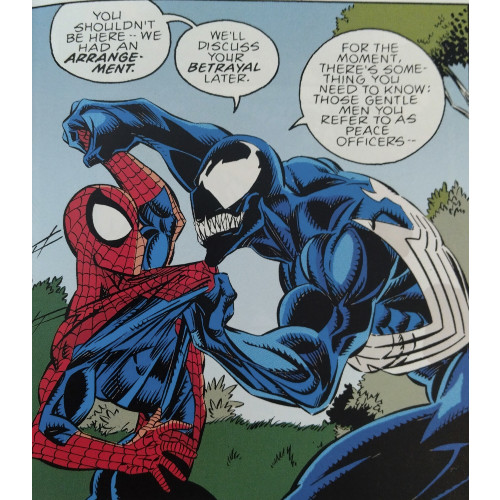
We're given a slight spectacle between the two, but so much of the plot is focused elsewhere, that even though this series is six issues long, there's not much done to juggle the Spidey/Venom conflict. There's not much attempt at reconciliation or Spidey trying to understand Venom's position. How about having Spidey try a little mentoring if Eddie is determined to turn over this new heroic leaf? None of that. Spidey is given an opportunity to understand Eddie as a character–we're given some additional, much-needed backstory for Mr. Brock–but it doesn't stop Spidey's intentions to web him up and haul him back to New York.
Part of this can be credited to the larger narrative Michelinie weaves, which I fully intended on calling utterly convoluted when I first read this series a few years back. It still is convoluted, but the narrative is not without its charms. Michelinie is, intentionally, setting Edde up somewhere different than New York and so lays some new ground rules…and underground rules. A hidden society of homeless people Eddie joins lives underground in an older section of San Fran, and one of our primary villains' intentions involves blowing these poor folks to pieces. The narrative is goofy and involves big machines and big guns and big mech suits, but this is the 90s; aren't we used to all of it by now? Goofy and convoluted, certainly, but not without its charm.
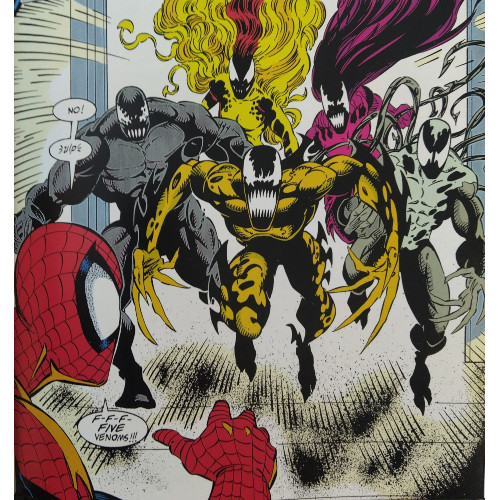
But Michelinie goes wider instead of deeper in some places, involving other characters, such as that batch of doomsday preppers called the Life Foundation and a group of armored thugs led by the father of one of Venom's first victims. Throw in some extra symbiotes, and you have no less than THIRTEEN separate adversaries which show up for the express purpose of attacking Venom. The whole bit is a lot to soak in, and with these groups of bad guys not necessarily connected to one another, their parts amble along, from action scene to action scene, until a new group conveniently takes over to move the plot into its next chapter.
Mark Bagley and Ron Lim provide pencils on this series, with Bagley illustrating the first half and Lim taking over for the second. Bagley finds what I'd call a "sweet spot" between various Venom designs we've witnessed, with Todd McFarlane's original design on the more conservative end and Eric Larsen's version of the character, with his massive jaw and lolling tongue, on the opposite end. Bagley threads the needle, providing a Venom a touch more monstrous than McFarlane's initial take but more reserved than what Larsen provided. Venom has fangs and claws and bulk, but he's not the more exaggerated character Larsen envisioned. He feels more practical, his musculature is well designed, enough to make him menacing without looking like a roided-out Frankenstein. Lim provides much the same, following safely in Bagley's footsteps.
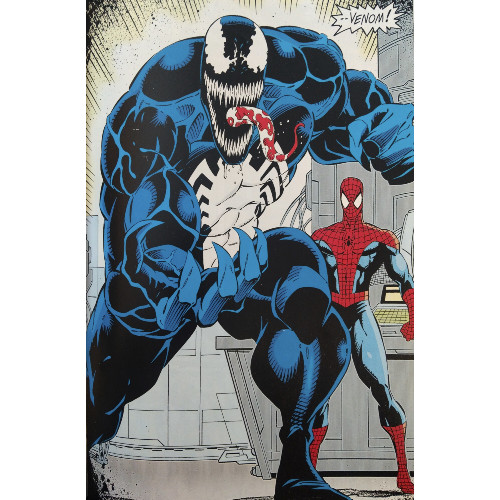
Is this a "bad" series? Kinda. I've been critical enough of it, and it might primarily be because I know Michelinie can do much better. I'm currently reading some post-"Stark Wars" material he wrote in Iron Man, and it's so much better. Instead of cheesy one-liners, the dialogue has weight. We don't get as much gravitas here, nor is Michelinie altogether successful in supporting his thesis statement: Venom can be a hero. Sure, I'd like to believe he can, but it can't be in Spider-Man's shadow. Cripes, Venom is Spider-Man's shadow, the thing that goes bump in the night under Peter Parker's bed. Venom needed the opportunity to thrive without Spider-Man breathing down his neck and maybe in a setting where thirteen villains weren't all coming after him. I feel he gets that opportunity in later series…you just won't find that here.